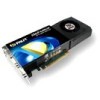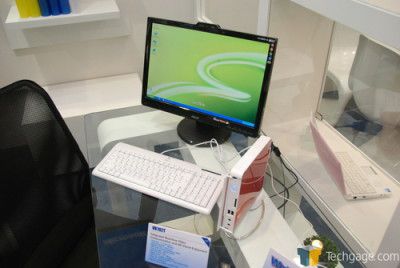- Qualcomm Launches Snapdragon 4 Gen 2 Mobile Platform
- AMD Launches Ryzen PRO 7000 Series Mobile & Desktop Platform
- Intel Launches Sleek Single-Slot Arc Pro A60 Workstation Graphics Card
- NVIDIA Announces Latest Ada Lovelace Additions: GeForce RTX 4060 Ti & RTX 4060
- Maxon Redshift With AMD Radeon GPU Rendering Support Now Available
Content and news by Rob Williams

Rob's Recent Content
Rogers Intercepts Personal Searches to Own Service
“Ugh” is about all I can say lately whenever thinking of Rogers, a company that loves pushing their customers’ buttons, because it’s fun, and profitable. After all, there’s a blatant lack of competition up here, so they could easily pull off any stunt they want. Who’s going to choose to go without their cable, Internet, cell phone and possible home phone? Exactly.
We all know about the iPhone plans, which still suck, but is old news. Last night, I found another reason to dislike the company… because they are now intercepting searches. Personally, I never touch the actual ‘Search’ box in Firefox, but rather just use the address bar. Since I try to stay away from Google as much as possible, I have it routed through to Live.com. When I used it last night though, I wound up with an image like the one below.

Ugh. So not only is Rogers taking it upon themselves to inject a message into your browser whenever you are close to hitting your monthly bandwidth quota (it can be argued how much of a problem this is), they are now overtaking your search in order to earn themselves even more cold hard cash. This is truly incredible, but not at all surprising.
This didn’t work on my families PC’s, who do use Google for their searches, so I’m not exactly sure how it works, or who would experience this ‘takeover’. Sure, you can disable this feature, but it’s stored via cookie, meaning once cookies are cleared, this ridiculous ‘feature’ is restored. The worst of it is that when I chose to disable it, using the address bar for searches would land me at the Rogers site again, but with a page error. Ugh. Canada needs a new fierce competitor (well, one to begin with), and soon.
Published on July 22, 2008Hackers on Planet Earth 2008: ‘The Last HOPE’
The seventh HOPE conference was held this past weekend in NYC and I was there to take in the numerous talks. Such subjects covered were lock picking, Wikipedia’s evils, YouTube, FOIA, hardware hacking and a lot more. Special talks were also given by Steven Rambam, Steven Levy, Adam Savage and Jello Biafra.
Published on July 22, 2008Intel Launches Centrino 2 Mobile Platform
Intel today has announced a major upgrade to their Centrino platform, which first debuted in 2003. Hard to believe it was that long ago, isn’t it? Between then and now, countless technology advancements have been made, so we were in huge need of such an upgrade. What’s new? Faster and more power efficient 45nm processors, upgraded WiFi connectivity and a whole lot more.
Let’s start with the six new processors. On the low-end, there is the P8400 2.26GHz, which features 3MB of L2 cache. It shares the same specs and TDP of 25W as the P8600, at 2.40GHz. For the higher-end mid-range (contradiction? nah) parts, there is the T9400 and T9600, at 2.53GHz and 2.80GHz, respectively. Both feature 6MB of L2 cache and a 35W TDP.
The biggest processor launch is the X9100, a 3.06GHz Dual-Core offering, featuring the same general specs as the others, but with an unlocked multiplier. All six of the processors have (finally) been upgraded to a 1066MHz front-side bus.
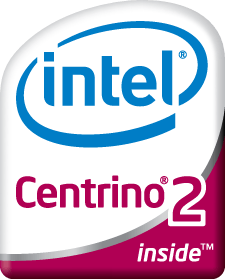
Processors is not the lone upgrade, of course. DDR3 support has been added, which is not-so-surprising since we’ve seen announcements from memory companies for well over a month now. S-ATA 3.0Gbps, eSATA and even ATI Crossfire support is added. Wait… Crossfire support? Yes, Crossfire support. Found deep within the press materials is mention of this, and given recent performance from the latest ATI GPUs, this is worth getting excited over.
Also on the graphics front, “switchable graphics” is a technology similar to Hybrid Crossfire, where one integrated GPU can be paired with a discrete one. This isn’t only to provide increased gaming performance, but also add to the power-saving aspect. This should really come in handy on large notebooks that generally eat up a battery like there is no tomorrow.
On top of all that, vPro has also been updated, along with the WiFi (450Mbps!) and products will be available soon. What we have to look forward to later this year are both Quad-Core offerings (though in small doses at first) and also a dual WiMAX/WiFi support, which would provide both kinds of support from the same module. The notebook forecast is looking good. Very good.
Published on July 15, 2008AMD’s HD 4870 X2 Gets Early Testing
When AMD launched their HD 4000 series last month, good things happened. Both cards (HD 4850, HD 4870) debuted at fantastic prices, and competed severely with NVIDIA’s recent offerings. It was the first time in a while we saw such a thing. Well, what could top that launch might be the X2 cards, starting off with the HD 4870 X2.
Our friends at the Tech Report have scored themselves an engineering sample and put it to some early tests. Compared to the older HD 3000 X2 cards, not much has changed in way of board layout, so it all lays with the performance now. Not surprisingly, the card delivers.
Interestingly, the card not only manages to out-perform SLI’d GTX 280’s in many tests, the performance between the X2 and dual HD 4870’s in Crossfire deliver almost identical performance. I might have to change my opinions from last week on the GeForce GTX 280, with new performance numbers like these. By the looks of things, it will all come down to price. Too bad we’ll have to wait a bit longer to see what those will be.
 Credit: Tech Report |
Although this product’s code name, R700, follows a naming convention similar to past high-end Radeon GPUs, it’s not really a new GPU at all. Instead, it’s just two RV770 graphics processors having a party together on one PCB, pretty much like the Radeon HD 3870 X2 was in the last generation. In fact, the new X2 looks an awful lot like the old one at first glance.
Published on July 14, 2008Albatron Refuses to Give Up on PCI
When the PCI-Express standard began to overshadow AGP, some people were upset. Sure, AGP was still capable, but PCI-E was pushing things towards the future. Faster bus speeds, lower latencies… perfect for the ultra-powerful GPUs we see today. So with AGP pretty-well phased out almost entirely now, who could even consider using a PCI slot for a GPU?
Apparently, Albatron. They have released three brand-new GPUs for PCI, those being the 8400 GS, 8500 GT and 8600 GT. Obviously, these are not meant to offer compelling gameplay experiences, but neither of these cards are that bad considering they should prove more powerful than many late-gen mid-range AGP cards.
Most interesting might be the fact that both the 8500 GT and 8600 GT feature HDMI output. The site doesn’t mention HDCP support, however, so I’m led to believe it’s not going to be suitable for HD video (no surprise, I guess). Pricing and availability is also not known, but if you just so happen to be in or around China, chances are these are readily available.

Albatron Technology has unveiled three new NVIDIA GeForce 8-series graphics cards that use the practically outdated PCI slot. While the appeal of the PCI8600GT-256X, the PCI8500GT-256X and the PCI8400GS-256 may not be obvious for anyone who has a PCI Express or even AGP slot on their motherboard, there are still quite a few systems (particularly small form factor or HTPC ones) where expansion options are limited, creating an niche market for these cards.
Published on July 14, 2008OCZ Introduces Elixir Gamers Keyboard
OCZ has today announced their first-ever gaming keyboard, the Elixir, which falls into the also-new Alchemy line of gaming products. The Elixir is the very first product under that line, but future products will follow, such as mice, keyboards other than this one and whatever else their labs feel like conjuring up.
I had a chance to see this keyboard at Computex last month and from what I saw, it’s a solid product. It looks good, has “gamer” colors, a soft arm rest and ten bright blue keys used for your macros. I believe the software included with the keyboard will have been built in-house at OCZ, just like the software for their Neural Impulse Actuator, so you know it should work well.
The keyboard also features seven Internet-related keys and another eight for multi-media. Happily enough, it also includes a space bar, which should come in handy. The absolutely best part? Well, it could be the $29.99US price tag. Seriously. My $25 Logitech keyboard will soon be getting a nice upgrade once these become available.

The Elixir is a high-quality keyboard featuring the necessary features such as 10 tri-mode programmable macro keys, mode selection, a pop-up menu shortcut, and Windows Media Players optical controller. The sleek design of the Alchemy Elixir Series will maintain your comfort throughout long gaming sessions with its membrane tactical keys made from 100% rubber-coating for no-slip comfort and ergonomic design.
Published on July 10, 2008Hackers On Planet Earth Conference Next Weekend in NYC
For our readers in the New York area who are still not aware of the HOPE conference happening next weekend, take this as one of your last reminders! The ‘Hackers On Planet Earth’ conference will be happening between July 18 – 20th and will be the seventh of its kind. Sadly, it also appears to be the last. As the 2600 staff seems to be cryptic with their answers, it’s unknown if this is truly the last one, or if there will be a successor under a different name. We’ll have to wait and see.
I’ll be attending the conference, and invite any of our readers to come along. We could meet up, have some laughs, drink too much… all the good stuff that should happen during a trip to NYC. Our own Matt Serrano will be attending one day as well. Since the last post I made, the entire list of speakers has been made, all divided by day, time and room.
The three primary rooms are named after notable technology-enthusiasts throughout the ages, including Grace Hopper, the creator of the first computer compiler, Alan Turing, another computer scientist who was responsible for the concept behind computer algorithms and Joe “Joybubbles” Engressia, a blind phone phreaker who could actually whistle the 2600 Hz tone with his mouth. Each room has a story behind it, and many more stories will be shared during the conference.
Pre-registration is done with, but you can still register at the door, for $75. Seems expensive, but it’s not really that possible to leave the event and not feel like it was fully worth it. You can check out the full talks list here and here.

There will be three days and nights of speakers along with all sorts of activities to keep you entertained and enlightened. We have a tremendous amount of space for us to make use of and it’s all right in the middle of the city, across the street from Penn Station. You still have time to get involved in this historic event, whether by attending, volunteering, speaking, or creating something new that none of us have thought of yet.
Published on July 10, 2008Voodoo “Unboxes” the Envy 133
It was only the other day that the veil was taken off of Voodoo’s new Envy 133, and now Rahul Sood, CTO for HP’s Gaming Business, has posted numerous “unboxing” pictures on his blog. You may just want to grab a towel to wipe off any potential drool.
This thing is gorgeous, and even the packaging is well-thought-out. The experience is designed to mimic one like opening a luxurious box of chocolates, or jewelry, or a Ferrari 599 GTB Fiorano, and I have little doubt that whoever purchases one will get a serious tingly feeling all over during the process. Aside from the box, other close-up shots are included as well, including the one below.
The only thing to really confuse me is the fact that the power button is inline with the rest of the keyboard, near where the DEL key usually sits. I could see this causing some potential issue, so I’m curious how they decided to prevent against accidental shutdowns. But, this is undoubtedly the best-looking 13″ notebook on the market, and yes, I do want one.
The lesser-known fact about this notebook is that it takes advantage of DeviceVM’s SplashTop, the instant-on Linux environment. As it seems, Voodoo’s attempt looks far better than anything to date, which makes sense given the notebook it’s to appear on.

Since we’re taking orders on the new Envy 133 now, we thought it would be a good time to demonstrate the packaging and the contents that come inside the box. Our packaging expert Allison worked with our ID folks to design the Envy 133 presentation box to look somewhat like a Tiffany box. It lifts up like a hat box to reveal a wonderful presentation, including the Envy 133 wrapped in a microfiber polish sleeve.
Published on July 10, 2008Seagate Announces First 1.5TB Desktop HDD, Mobile 500GB 7200RPM
It hasn’t even been long since we first saw 1TB drives hit the market, but here Seagate goes and throws 50% more storage into the same amount of space. Seagate claims that this bump is the largest ever, in the over fifty years that hard drives have been around. Of course, this is all thanks to the much-touted perpendicular magnetic recording.
The new Barracuda 7200.11 features four platters (at what would be 375GB each) and promises a sustained data rate of up to 120MB/s. We’ll have to wait for the reviews to see just how accurate this measure is. Like Seagate’s other higher-end drives, this one will feature 32MB of cache, which I actually have found to make a reasonable difference in my personal machine for copying smaller sets of files.
In addition to the new Barracuda 7200.11, Seagate also announced a new flagship Momentus 7200.4 500GB, a mobile offering that offers both lots of storage space, in addition to fast 7200RPM speeds that we are used to on the desktop. It took a while to happen, but you can now be a mobile warrior and actually have the storage and speed you’d like. Neither of these two products have suggested prices, but we’ll find out next month when they are launched into the market.
Update: Seagate tells us that the 1.5TB Barracuda 7200.11 will carry an SRP of $450. No pricing information available for the Momentus drive yet, however.
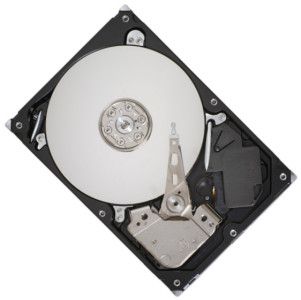
The debut of the Barracuda 7200.11 1.5TB, the eleventh generation of Seagate’s flagship drive for desktop PCs, marks the single largest capacity hard drive jump in the more than half-century history of hard drives – a half-terabyte increase from the previous highest capacity of 1TB, thanks to the capacity-boosting power of perpendicular magnetic recording (PMR) technology.
Published on July 10, 2008Amarok 2.0 Alpha 1 Released
It’s been a relatively long-time coming, but the first 2.0 alpha release for the popular Linux audio player, Amarok, has now been released. Since 2.x is highly dependant on KDE 4 libraries, that desktop environment is required in order to run it. Those of you, like me, who would rather stick with 3.5.x for the time-being, will have to miss out. The good news in all of this, though, is that the future player will work on Windows and OS X.
What’s new though is brand-new graphics and ‘innovative user interface’. At first look, I’m really skeptical, but I’m going to hold off on my opinions until I get a chance to spend some good time with it. I’ve been using Amarok 1.x for so long now, I’m almost scared about taking such a leap forward, because there’s definitely a noticable difference here.
But I digress. Also new is a nice Internet service framework, allowing fantastic integration with popular music services, like Last.fm, Magnatune and others. I assume that these will simply run better and be easier to navigate than 1.x, since those services were available there. There’s lots of good stuff though, so you will need to either read through the news post or get on downloading and testing it out. I’m so tempted to finally install KDE 4 just for this reason…

Don’t miss several UI innovations like the Plasma powered Context View, new space efficient playlist, and amazing PopUp Dropper! The new Context View allows you to show all the context information you care about. We expect a lot of Plasmoids to be provided by the community in the first months after the release of Amarok 2.
Published on July 10, 2008Palit GeForce GTX 280 1GB
With so many options on the market right now, what makes the GTX 280 a good choice for anyone? The fact that it is the highest-performing card out there sure helps, but it’s still not for everyone. To join this club, you better hope you have one massive resolution to push.
Published on July 10, 2008NVIDIA Supporting PhysX-on-Radeon Effort
NVIDIA’s PhysX technology has been getting a lot of attention lately, and in case you happened to miss our coverage from two weeks ago, be sure not to skip it as we take a hard look at the performance factor, and also see where the technology stands today. But where does ATI fall into the PhysX scheme of things? Well if Eran Badit has his way, ATI cards will soon join NVIDIA’s own and utilize the technology to its full potential.
Around the same time we posted our article, Eran leaked a screenshot that showed PhysX running on an HD 3850, and I immediately assumed NVIDIA was going to jump in and ask for him to remove it. It wouldn’t be the first time the company has asked him to remove certain NVIDIA-related material off of his site, after all, so what’s so surprising now is that the company is actually supporting his endeavour. Impressive.
What’s not impressive is the blatant lack of support from ATI, who likely wishes this would just go away. After all, they recently signed into a cooperation with Intel using their Havok technology, essentially the leading competitor to PhysX, although currently more successful. A software package to support PhysX on ATI is inevitable though, and I’m glad to see it. PhysX can be accelerated using hardware, whereas Havok currently has no such functionality. That in itself puts PhysX in a good place, and adding support to ATI cards is only going to improve the technology and help it grow.

The tone at Nvidia has changed quite a bit over the past week. It appears that Nvidia does not mind running PhysX on ATI Radeon (or just about any other GPU) cards. In fact, Nvidia has opened access to Developer Relations and is providing assistance to Badit, including access to documentation, SDKs and more importantly, hardware and actual engineers.
Published on July 9, 2008Mega Man 9 to Resemble Old-School NES Title
If you consider yourself to be a true gamer, then chances are that you fully believe that gameplay should always come before graphics. There is no shortage of great-looking games on the market today, but many of them fall far short in the gameplay department. I won’t name examples, but the sad fact is that it’s difficult to get a game that excels in both. Half-Life 2 is one recent example of where this was accomplished, but I’m sure each one of us would agree on a different game that really blew us away.
So what am I getting at? As it turns out, popular developer Capcom is revisiting its roots with Mega Man 9, a brand-new game designed to mimic one for the original NES. That means the graphics, sound and gameplay should closely resemble what we saw with Mega Man 2 – 6, which is no doubt going to please many diehard MM fans. The best part might be the price of $10 upon release. The downside? It will only become available on the Wii’s download store. At least for now.
The release is likely nowhere soon, but you could probably expect it sometime Q4. For now, you can check out a few other “simpler” games I recommend, such as Within a Deep Forest, Everyday Shooter and Gumboy Crazy Adventures.

Upcoming Budget Intel E5200 Dual-Core Overclocks to 4.0GHz
Popular overclocker coolaler has gone and acquired himself an Intel E5200 processor, due out sometime this quarter, and pushed the humble chip to its breaking point. The processor itself comes in at 2.5GHz with an 800MHz bus and scales back to 2MB of L2 cache. It uses a 12.5x multiplier and sticks to the 65W thermal envelope. Though pricing and release information has not yet been announced, the chip is rumored to cost around $84 per 1,000 units.
Now, I thought the 4.0GHz+ I hit in our E8400 Core 2 Duo review was impressive, but coolaler took his E5200 all the way up to 4.0GHz on what seems to be air cooling, given the relatively warm temperatures. That is impressive, and might just make this chip a serious option for those who don’t need the extra cache.
What I find most interesting though, is the fact that the CPUID information in the CPU-Z shot labels the chip as a “Pentium(R) Dual-Core CPU”, so that’s likely exactly what it will appear as on the store shelves. In addition to the lower FSB and lesser cache, it appears the chip also lacks the SSE4 instruction set. This won’t matter to people who don’t render multimedia with applications that use it, but it’s a notable loss regardless. Still, 4.0GHz for >$100? Try complaining about that!

Running Linux Applications Under Windows
There wouldn’t be too many Linux users out there who haven’t thought about running a Windows application on the OS. Chances are many of them have done it as well, and why not? Wine is so sophisticated nowadays, that many Windows applications run without much of an issue. I personally use it for Steam, to play the odd simple game from time to time.
How about the other way around? A new entry in Wired’s How-To Wiki has a few great ideas on how to accomplish just that, and quite easily. The most interesting to me is a solution called ‘andLinux’, an Ubuntu-based distribution that runs in Windows. ‘In’ is bold because it literally does run in Windows, alongside Windows’ own kernel.
I haven’t tested it out myself, but I plan to as it’s a very interesting concept. It shows the ability to run many Linux applications from an icon in the systray, and they appear using Windows’ own theme. Other ideas on the wiki include Ubuntu’s Wubi and Cygwin. Well worth a look if you are just dying to have a kick-ass Linux application (like Amarok, featured below) in Windows.
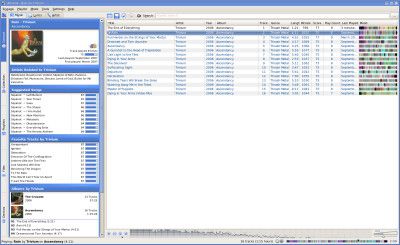
AndLinux isn’t quite the same thing as WINE, since andLinux actually loads the full Linux kernel, but andLinux does make Linux apps look like they’re running natively on Windows. In other words, they behave somewhat like Windows apps running in the “Coherence Mode” of Parallels or “Unity mode” of VMWare on the Mac.
Published on July 9, 2008ASUS Eee Box Specs & Pricing Unveiled
It’s now been over a month since ASUS first unveiled their Eee Box mini-PC, and now the specs are starting to slowly trickle out. According to Stuff.tv, the unit will retail for £199 ($392 USD) and include Windows XP Home, two USB ports, a card reader, DVI video output, Ethernet and an 80GB hard drive. All in all, a modest rig, but given its overall size, we didn’t expect much more.
Any way you look at it, though, this PC looks to be a relative steal. It comes in an ultra-portable size, like the Eee PC, and though I haven’t seen the two side-by-side, I would assume the Nintendo Wii is actually bulkier. In addition to its elegance, the Eee box even includes a keyboard and mouse. Now that seems like a good deal.
Although I don’t recall the exact specs sheet that I saw at Computex last month, I do know that the Eee Box is fully capable of churning out 720p content, which is helped by the latest Intel Atom processor. So, despite it’s small frame, this is one capable little machine. Add a wireless keyboard and mouse to the package and you have one heck of a stylish system that might actually be the focal point of your room for all the right reasons.
Published on July 9, 2008Backing Up Windows Drivers with DriverMax
Formatting your PC and starting from scratch can give you a great feeling. Months or even years worth of junk buildup is gone, and you can start your computing journeys anew. One of the least fun aspects of the task is re-installing everything, including your system drivers. If you have ever found yourself becoming frustrated with this chore, then DriverMax might be worth a look.
The name implies that it works with your drivers, and that’s exactly what it does. You will still need to re-install all of your applications, but at least this helps out a bit, right? After installation, you will be able to scan your PC for currently installed drivers, then have the ability to export them into a folder of your choosing. Once you are on the new machine, you can simply import them and be on your merry way.
The program is free, but you’ll need to fill out your e-mail address in order to get a registration code. Why? Who knows, but hopefully it will result in absolutely no spam. Worth a look, though, especially if you happen to reformat quite often.
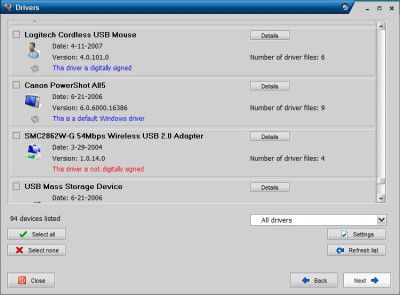
After installing DriverMax, go into Driver Operations and click on Export drivers. A list of all your installed drivers will be displayed and you can pick and choose which ones to export, or simply export the whole lot in one go. Once you’ve reinstalled Windows, go back into Driver Operations, click on Import drivers, and point to the folder containing your saved drivers.
Published on July 9, 2008Voodoo Envy 133 is Expensive, but Gorgeous
Big notebooks are out and small notebooks are in. I personally didn’t realize how great smaller notebooks could be until I first took a look at a Hypersonic offering back in May, then proceeded by an ASUS offering which shared the same form-factor. I don’t recall a time when my opinion on things has ever shifted so fast. I am now such a fan of smaller notebooks, I almost scoff at anything larger!
With the smaller size, however, higher prices will be seen. Although the ASUS and Hypersonic I took a look at before hover around $1,500, “luxury” models exist that cost much more. Take Lenovo’s X300, for example, or the MacBook AIR, which retail for over $2,500. But then we have the Voodoo Envy 133, which easily becomes the best-looking ‘small’ notebook on the market, and comes in at 13.3″.
The prices are not that subtle either, with most of the best models sitting at over $3,000. The basic model which includes a 1.6GHz Intel SP7500 CPU and 80GB HDD retails for $2,099, which isn’t too bad, given the gorgeous design. The $3,399 model will bump up the processors speed, give you some software to deal with and also give you a 64GB SSD. Expensive, but wow, is it easy to look at.
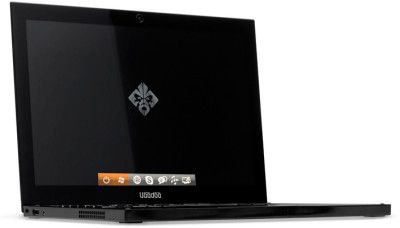
Developed by the HP Voodoo Business Unit, the Voodoo Envy 133 delivers critical features such as wireless(2) and Ethernet connectivity, USB and HDMI ports, and a 13.3-inch diagonal backlit LED display. All of the features are wrapped in a visually stunning package that consumers can customize via a full pallet of Voodoo Allure paint finishes.
Source: Voodoo Envy 133
Published on July 8, 2008Hasselblad’s Kodak CCD-equipped H3DII-50 Offers 50 Megapixels
No matter the technology, people enjoy seeing higher numbers. Faster processors, more memory, more horsepower and of course, more megapixels. The company to reign supreme in that arena for a while has been Hasselblad, who are now offering the H3DII-50, a 50 megapixel monster, utilizing Kodak’s latest highest-end 36.8×49.1mm sensor.
The camera’s price is not yet known, but considering the ‘smaller’ H3DII-39 retails for just under $34,000, then you could expect the latest iteration to score upwards of $40,000. But what kind of resolution avails you with a 50 megapixel CCD? How does 6132×8176 sound? As incredible as that may appear, it sure doesn’t seem that much more impressive over the 39 megapixels 5412×7212. But as simple math will prove, the higher we go in megapixels, the slower the overall resolution will increase to our eye.
But still, 50,000,000 pixels from a single image is simply incredible. To put it into perspective, a 1680×1050 monitor comes close to 1.8 million pixels, while the current monster, 2560×1600, sits at a comfortable 4.2 million pixels. That’s not the most impressive part, though. Each image taken with the H3DII-50 will weigh in at around 70MB a piece. Not only is the camera itself expensive, but the computer you’d need to handle the images would also have to be.
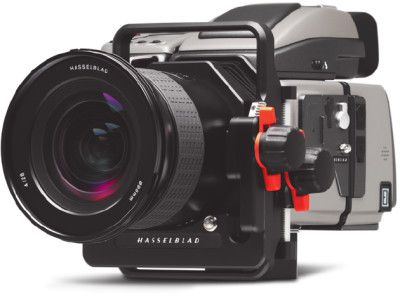
To fit more pixels on the same chip, Kodak had to perform some voodoo shrinkage on them; they’re 6 microns, compared with 6.8 for the KAF-39000. Kodak claims that the chip has increased data throughput, which seems odd since the specs (which are admittedly stamped “preliminary”) indicate a maximum throughput of 18MHz vs. 24MHz for the 39-megapixel CCD.
Source: C|Net Crave
Published on July 8, 2008Hans Reiser Leads Authorities to Wifes Body
We haven’t covered the Hans Reiser trial to any great degree, due to it not being something of particular interest to most of our readers, but it’s a twisted tail regarding what used to be a very popular software developer. Hans was first accused of murdering his wife in late 2006, and since then the entire legal process and trial has taken well over a year and a half to conclude. When it did, he was found guilty, though no body was ever recovered.
That led many to believe that Hans could have still been innocent, but his sketchy demeanor worked to hurt more than help him. News is out today, however, that he led authorities straight to Nina’s body, proving that he was indeed the creep behind this horrible crime. His cooperation means he will be eligible for parole after 15 years, rather than the original 25.
What this means for ReiserFS is probably certain doom. Many of the largest Linux distributions gave up on the file system long ago, including SUSE, and it even seems to be getting weened out of the Linux kernel itself. We’ll have to wait and see, I guess. I do recommend reading the Ars Technica quickie article on this, though, if you happen to love play on words, like the one in the quote below.

Our postmortem analysis of the ReiserFS mailing list, however, seems to indicate that the project is already beginning to fall apart. Ongoing development has been relocated to kernel.org, but the effort could be doomed to bitrot because developers don’t seem particularly interested in taking a stab at maintaining the code.
Source: Ars Technica
Published on July 8, 2008Older Entries
Newer Entries
Copyright © 2005-2025 Techgage Networks - All Rights Reserved.
About Us | Advertise | Terms & Conditions | Privacy Policy





